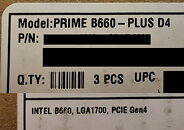
Intel 12th Gen Core "Alder Lake" Models Bound for January Pictured
Here are some of the first pictures of the 12th Gen Intel Core "Alder Lake" desktop processor models that are expected to join the lineup in January 2022. Intel debuted the series with unlocked "K" and "KF" SKUs, with "locked" SKUs saved for next year. Pictured here are the Core i9-12900, the Core i5-12600, the i5-12500, and the i5-12400. The S-SPEC codes for these processors are SRL4E, SRL4F, SRL4G, and SRL4P, respectively. Our older article details their possible specifications. The lineup isn't limited to these models. Others include the Core i7-12700, and the "F" variants of many of these SKUs, which lack integrated graphics, allowing those with discrete graphics cards to save a little.
Besides these processors, Intel is expected to expand its motherboard chipset options. Currently, Z690 is the only chipset option for the LGA1700 socket. Upcoming chipset models are likely to include the H670, W680, B660, and perhaps even the H610. Intel could use platform I/O for segmentation of these chipsets, besides lack of CPU overclocking support. A big change with the 12th Gen desktop processor lineup concerns Core i5. While the i5-12600K and i5-12600KF feature 6 P-cores and 4 E-cores, the other Core i5 SKUs, including the i5-12600, lack E-cores. The source installed these processors to confirm that the i5-12600 is indeed based on the "H0" silicon and lacks E-cores.
Besides these processors, Intel is expected to expand its motherboard chipset options. Currently, Z690 is the only chipset option for the LGA1700 socket. Upcoming chipset models are likely to include the H670, W680, B660, and perhaps even the H610. Intel could use platform I/O for segmentation of these chipsets, besides lack of CPU overclocking support. A big change with the 12th Gen desktop processor lineup concerns Core i5. While the i5-12600K and i5-12600KF feature 6 P-cores and 4 E-cores, the other Core i5 SKUs, including the i5-12600, lack E-cores. The source installed these processors to confirm that the i5-12600 is indeed based on the "H0" silicon and lacks E-cores.



























































